
• 1
Ij I ' .1
i
PLATE DLXXVIII.
i E G I P H I L A DIFFUSA. Fig. 1.
Spreading ^giphila.
CLASS IV. ORDER L
TETRANDRIA MONOGYNIA. Four Chives. One Pointal.
ESSENTIAL GENERIC CHARACTER.
C a l y x 4-dentatus. Corolla 4-fida. Stylus semibifidus.
Bacca bilocularis^ loculis disperili
is.
CUP four-toothed. Blossom four-cleft. Shaft
cleft half-way down. Berry two-celled,
cells two-seeded.
SPECIFIC CHARACTER.
JEGIPHILA foliis ovato-lanceolatis, longè acuminatis,
utrinque glabris ; paniculis diflfusis
axillaribus et terminalibus ; staminibus tubo
vix excedentibusj stylo longissimo.
JEGIPHILA with oval-lanced, long pointed leaves,
smooth on both sides; panicles spreading,
axillary, and terminal; itamens scarcely
longer than the tube, and shaft very long.
t E G I P H I L A OBOVATA. Fig. 2.
Inversely Oval-leaved JEgiphila.
SPECIFIC CHARACTER.
jEGIPHILA foliis obovatis acuminatis, utrinque
glabris ; paniculis axillaribus et terminalibus
; pedicellis calycibusque minutè pubescentibus.
^GiPHiLA with leaves inversely oval, pointed
and smootl) ; panicles axillary and terminal;
flower-stalks and calyxes minutely pubescent.
REFERENCE TO THE PLATE.
1. The empalement.
2 . A blossom spread open,
3. Seed-bud and pointal, as it appears in the opening buds.
4 . The same when fully expanded.
THIS very natural genus was established by Jacquin from the Bois Cabril of the Creoles in Martinico
a shrab, the young shoots of which are greedily sought for and eaten by their cattle, particularly goats^
whence the name (in English) Goatwood; and which Jacquin, following the botanical canon, elegantly
turned into ^gipl i i la. With this species the celebrated Swartz has conjoined the Knoxia of
Browne's Jamaica and Manabea laevis of Aublefs Guiana, and added two more species, JE. foitida and
JE. trifida, discovered by himself; and Willdenow has yet further augmented it with the Manabea villosa
and arborescens of Aublet, and the Nuxia of Lamarck : tlie last, however, we consider as a very
doubtful species. That fine collection of plants from the West Indies, introduced in ISO7 by lord
Seaforth, and by him presented to A. B. Lambert, esq. and which we have already so often quoted,
has brought to our knowledge two more species, which we have denominated diffusa and obovata, fiom
what appeared to us to be their most prominent features. Both shrubs are natives of the West Indies,
and were sent to us in flower in August 1808. They are propagated by cuttings, and have not yet
ripened seeds in England, but produce flowers annually in abundance during the months of July and
August.
I -i ;
'à
•r-
1:1
: .11
1
: . i'ii':
i: It !i
•f^ •••.iriri
• i'. •^¡•'l' : ri.,
il , f
I ! : ! -
X 4
!il;llil
•ifi
- 1Ì:Ì::Ì|I'
iii'
•I't
i